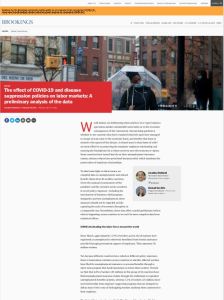Join getAbstract to access the summary!

Join getAbstract to access the summary!
Jonathan Rothwell and Hannah Van Drie
The Effect of Covid-19 and Disease Suppression Policies on Labor Markets
A Preliminary Analysis of the Data
Brookings Institution, 2020
What's inside?
Varying policy responses to COVID-19 offer insights into the potential for economic recovery.
Recommendation
How can governments contain the coronavirus without doing severe damage to workers? The challenge is ongoing, testing policy makers’ mettle and ability to act strategically. In this astute analysis, economists Jonathan Rothwell and Hannah Van Drie look at the initial results of measures taken in 20 nations. Their tour of the countries’ different approaches highlights that those economies doing the best at navigating the treacherous path between physical affliction and economic ruin are focused on buttressing the employer–employee relationship.
Take-Aways
- Governments have taken different approaches to containing the spread of the coronavirus while limiting economic damage.
- Research on preliminary results contains some unexpected findings.
- Policy makers’ strategies to tackle the pandemic carry important implications for social safety nets and labor economics.
Summary
Governments have taken different approaches to containing the spread of the coronavirus while limiting economic damage.
Policy makers’ attempts to achieve a sweet spot that controls the spread of COVID-19 and allows the economy to function have varied greatly, as have their results. In a study of 20 advanced nations, different public health measures – such as mandating physical distancing – did not correlate with the extent of economic damage incurred by a country.
““Preliminary results do not suggest any strong tradeoff between disease suppression and economic performance.””
As measured by “a COVID job displacement rate,” deaths per capita and tests per capita, New Zealand, Australia, Denmark and Germany are achieving reasonable success in both containing the virus and maintaining a strong foundation for economic recovery. But the United Kingdom, United States, France and Switzerland are performing poorly, with higher per capita mortality and greater economic disruption. For example, as of April 24, 2020, Germany had suffered 64 deaths per capita, compared to an average of 135 for all 20 countries in the study. At that time, some 20% of Germany’s labor force had enrolled in temporary work arrangements funded by the government, and unemployment insurance claims dipped. Germany’s focus on supporting businesses in an effort to keep people working maintains the connection between employers and employees that is essential for a solid comeback.
Research on preliminary results contains some unexpected findings.
Countries with social distancing and testing measures that have tamped down mortality rates have not always achieved desirable economic outcomes. And economic policy responses, whether directed to helping businesses keep people employed or to supporting laid-off workers through unemployment insurance, cannot fully measure the extent of economic upheaval. Nonetheless, the Scandinavian countries of Iceland, Sweden, Denmark and Norway took different tacks and generated unanticipated results.
“Keeping the economy open has not saved countries from severe economic disruption.” ”
The economic policies in all four countries emphasize unemployment insurance; Sweden and Denmark also include temporary work programs. Sweden and Iceland both have loose social restrictions, but Sweden’s testing program has been minimal, while Iceland’s has been aggressive: Sweden’s death per capita reached 198, compared to Iceland’s 28. Both countries have experienced economic turmoil in line with that of Norway and Denmark, nations with strict social distancing rules. Widespread testing and selective quarantining seem to be keeping mortality low.
Policy makers’ strategies to tackle the pandemic carry important implications for social safety nets and labor economics.
Officials need to understand the importance of the employer–employee relationship to the pace of economic recovery. Replacing fired workers is time-consuming and expensive, entailing orientation and training to attain the productivity of an experienced employee. Historical US data show “that 60% of unemployed workers do not return to their employer.” Accordingly, programs that furlough rather than terminate employees are vital to economic resurgence.
About the Authors
Jonathan Rothwell and Hannah Van Drie are economists at the Brookings Institution.
This document is restricted to personal use only.



















Comment on this summary